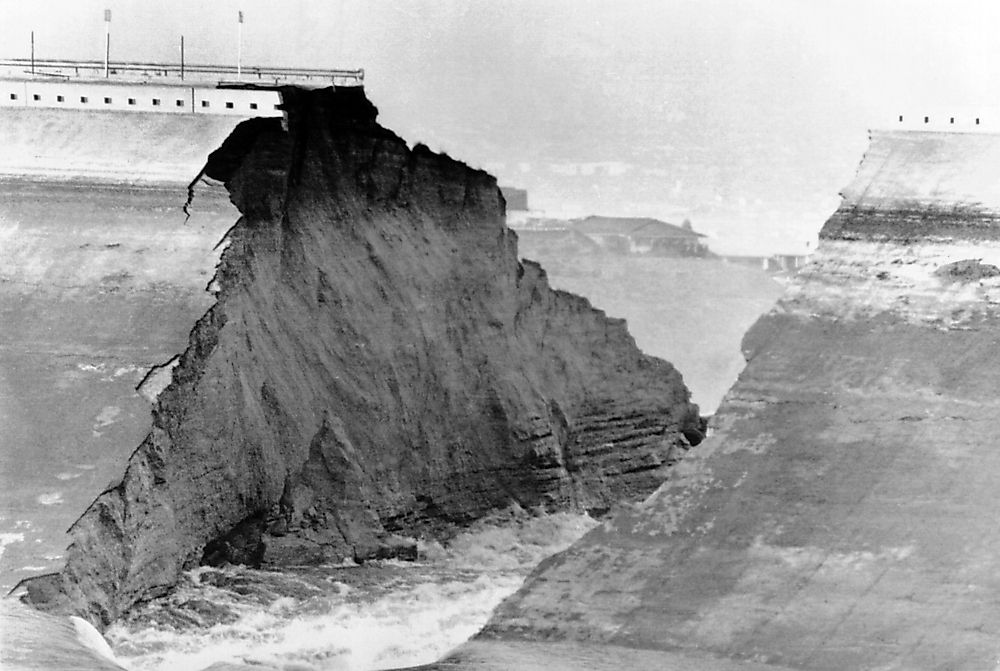The Deadliest Dam Failures In History

Dam building is an ancient concept. Some of the earliest functioning dams were built in the 1st and 2nd century AD. Dams are built to serve various functions like supplying water for irrigation, flood control, and generations of hydroelectricity. Dams are also associated with several disadvantages like loss of ecological balance in the areas where they are built, displacement of people and wildlife in such areas, etc. Worse happens when dams fail or give way. When a dam bursts, there is a sudden release of massive volumes of water which flood areas around the dam causing extreme loss of lives and property. Here is a look at some of history's worst dam failures:
The 1975 Banqiao Reservoir Dam Failure
The failure of the dam on the Ru River in China’s Zhumadian City was the deadliest dam failure ever. The construction of the Banqiao Dam was initiated in April 1951 and completed by 1952. It was established with the aim of controlling floods downstream and also generating hydroelectricity. The reservoir of the clay dam had a total capacity of 492 million cubic meters. Although initially, the dam exhibited several cracks and signs of other constructional errors, after the repairs, it was claimed that the dam was unbreakable. On August 1974, Typhoon Nina struck the region and its collision with a cold front resulted in excessive rainfall in the area. Finally, on August 8, the catastrophic disaster struck as the dam gave way and massive volumes of water engulfed the nearby areas. The dam failure caused an estimated 171,000 deaths. Millions of people were also displaced and huge losses to property were also recorded. Later, the dam was rebuilt.
1889 South Fork Dam Failure
The South Fork Dam was built on the artificially created Lake Conemaugh in Pennsylvania, the US between 1838 and 1853. On May 31, 1889, the dam burst and led to a massive disaster involving the loss of 2,209 human lives. The disaster resulted from incessant and unprecedented rainfall. As the dam gave way, nearly 20 million tons of water rushed into the nearby towns, washing away all that came in the path of the floodwaters. The disaster was termed the Johnstown Flood as the town of Johnstown was one of the worst affected places during this disaster.
The 1963 Vajont Dam Failure
The Vajont Dam was constructed in 1959 across the Vajont River in Erto e Casso municipality in Venice, Italy. Disaster struck on October 9, 1963, when during the initial filling, a landslide triggered a megatsunami in the lake created by the dam. About 50 million cubic meters of floodwater lashed onto nearby towns and villages in the form of an 820 ft high wave. 1,910 human deaths were recorded in this disaster. It is claimed that there were early signs that the disaster would happen since the dam was located in a geologically unstable area. However, these signs were largely ignored by the concerned authorities.
1967 Sempor Dam Failure
This embankment dam exists on the Sempor River in the Indonesian Gombong District. The dam serves as both a source of waters for irrigation and a recreational area for tourists. Added services include flood control and hydroelectricity generation. The dam is associated with a disaster in the same year as its construction which is 1967. On November 29, 1967, floodwaters resulting from flash floods in the region over-topped the dam leading to its failure. Many people were killed in the three nearby towns. Heavy loss of property was also incurred. Following the disaster, the dam was rebuilt and completed in 1980.
The 1943 Möhne Reservoir Failure
This Möhne Reservoir was created by damming two rivers, Heve and Möhne. The reservoir is located in the North Rhine-Westphalia in Germany. The dam on the reservoir was subjected to bombing during the Second World War. On the fateful night of May 16 to 17, 1943, bouncing bombs were targeted at the dam by RAF Lancaster Bombers. The protective nets hanging on the water were unable to stop the bombs. A massive hole was created on the dam that allowed water to spill over and flood large areas around the dam. At least 1,579 people lost their lives in this human-induced disaster. Of those who died, 1,026 people were foreign laborers who were forced to work in Germany and lived in camps near the dam.
The 1961 Kurenivka Mudslide
On March 13, 1961, a dam that secured the loam pulp dump of a brick factory near the capital city of Kiev in Ukraine, gave way due to heavy rains. Disaster struck as massive volumes of pulp moved at great speeds down the hill slopes into the inhabited area below. Although official reports mentioned only 146 fatalities, it is believed over 1,500 human lives were lost in the disaster. In the aftermath of the disaster, several engineers and managers responsible for designing and building the dam were convicted.
1961 Panshet Dam Failure
This dam is located on the Ambi River near Pune in India. The dam was built in the 1950’s and serves to provide water for irrigation and drinking purposes. On July 12, 1961, disaster struck when the wall of the dam burst due to faulty construction, and Pune was flooded. At least 1,000 people lost their lives in the disaster. The dam was later rebuilt.











